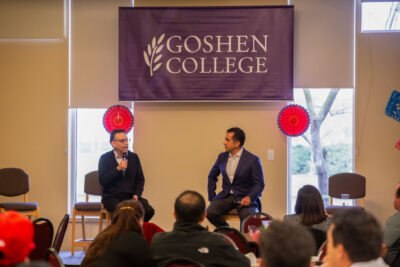The October meeting of Goshen College’s Board of Directors allowed student representatives to be a part of one of their meetings as they discussed strategic planning, the hiring policy and enrollment.
The Board members arrived on campus before fall break for several meetings, which focused on the college’s mission and future. The board is currently made up of 12 members from nine states and it meets three times a year.
In this most recent meeting, the board passed a budget for the upcoming year, noted the growth of the college’s endowment, discussed the hiring policy and the college’s reaccreditation process and brainstormed strategies to increase the school’s lagging enrollment. The board also reviewed a five-year plan called Unfolding Hope that aims to reimagine GC with a specific series of goals as the college undergoes its reaccreditation process.
The three “anchor statements” described by the plan are to relentlessly focus on student learning, tenaciously attract and retain more students and constantly evaluate and adapt to ensure long-term institutional strength.
President James Brenneman said students could potentially see a stronger mentoring environment on campus and more career pathways for majors and minors as Unfolding Hope is implemented, along with other opportunities for students. Brenneman also said that the board asked the college to work to focus the plan further in the coming months in order to provide opportunities for feedback from faculty, staff and students.
In addition to meetings solely between board members, each fall the board also meets with students, whose representative organizations are chosen by Student Senate, to gauge campus opinions on the running of the college. This year 12 students from Student Senate, Latino Student Union, Black Student Union, International Student Club, GC Open Letter, the athletic department and commuters met with the board.
According to David Zehr, Student Senate president, the meeting was a two-way conversation, with both students and the board legitimately interested in the roles of the other.
“The board created a space where they wanted to hear what students had to say,” Zehr said. “It was a dialogue.”
Cecilia Lapp-Stoltzfus, a sophomore Senate member, thought the meeting was helpful in showing the board that the student body cared about the future of the school and wanted to be invested in its future.
“I don’t think board members realized that we [students] wanted that relationship,” she said. “Students have the desire to work with the administration and board, and this meeting helped the board realize that.”
GC’s hiring policy was a significant point of discussion over the weekend as well.
Speaking on behalf of the board at the all-staff meeting this Monday, Brenneman said “The board acknowledges that there are and will be diverse perspectives on the hiring policy.”
According to Brenneman, the board has decided to wait until after the Mennonite Church USA general conference this summer in Kansas City to make a decision regarding the policy.
Stefan Baumgartner, a senior, represented GC Open Letter at the student-board meeting and left feeling encouraged by the board’s interest in student opinion regarding the hiring policy.
“We were in a think tank,” he said, “they wanted to know what is happening on campus, what would happen if the policy did change.”
Zehr noted that the primary focus of the student-board meeting, however, revolved around the integration of diverse student groups on campus and how to encourage relationships between these groups in which they support and benefit each other.
Recent administrative decisions as well as the college’s ideas to increase student enrollment were covered as well, with both students and the board expressing a strong interest in the vision of the college in years to come.
“These have become supper time conversations,” Zehr said. “Students are talking about enrollment, admissions, long-term sustainability of the college.”
Both Zehr and Lapp-Stoltzfus agreed that this observation somewhat surprised the board. With the board acknowledging the student body’s desire to know about the board’s actions and visions for Goshen, the meeting likely served as the start of further conversation between the two groups.

